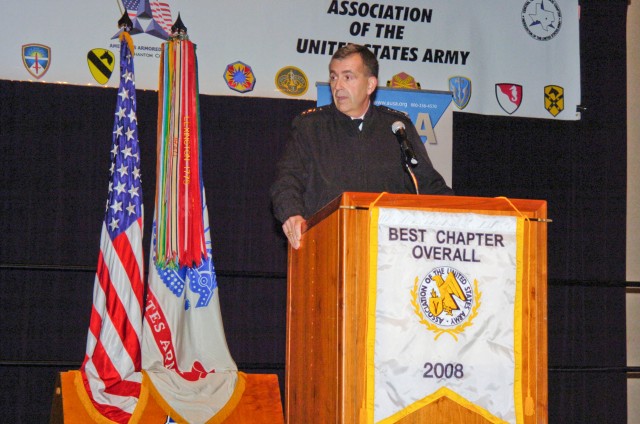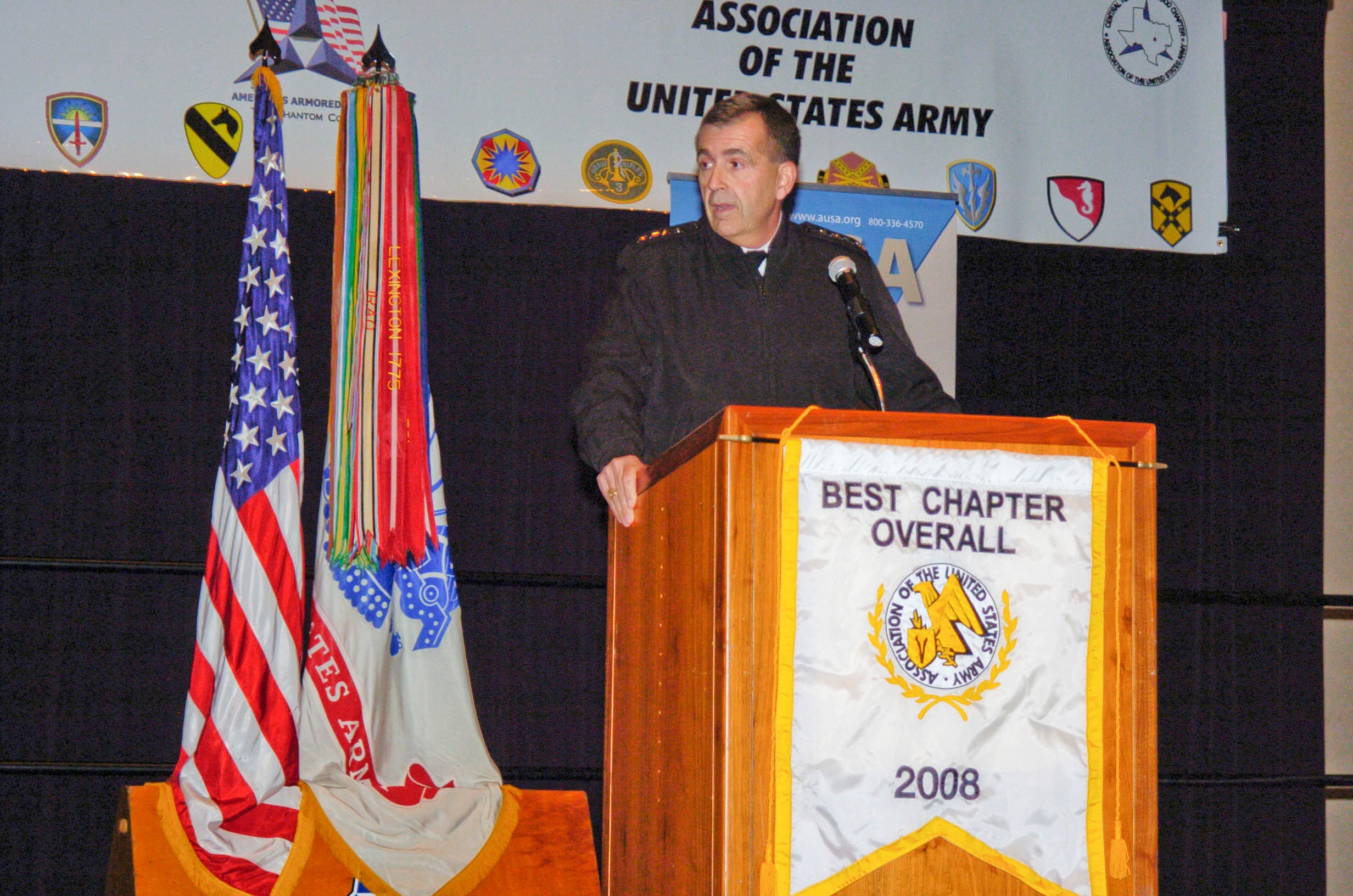FORT HOOD, Texas (March 27, 2009) -- Demands on the force, tough economic times, a drop in Fort Hood's population and mounting suicides in the Army were on the mind of Vice Chief of Staff of the Army Gen. Peter Chiarelli when he addressed the March 18 Central Texas - Fort Hood Chapter of the Association of the U.S. Army general membership meeting at the Killeen Civic and Convention Center.
Chiarelli came to the AUSA meeting "to personally reassure that the Army is going to do everything in our power to help you through the challenging times ahead."
Chiarelli noted that Solders constantly are called on to do more with less ands are "given far greater responsibility than in the past."
Echoing Defense Secretary Robert Gates announcement from earlier that day, the general said the Army is moving away from phased stop loss, the practice of keeping Soldiers in the Army beyond their commitments.
In the plan to eliminate stop loss, reserve component members will be released from stop loss first.
Active-duty Soldiers will follow suit, with the last unit expected to be stop lossed in August or September.
"The Army will begin in January deploying units no longer on stop loss," Chiarelli said.
Although the Army will no longer be deploying Soldiers who are under stop loss, there will still be Soldiers in country on stop loss, Chiarelli added.
Soldiers currently stop lossed and deployed will remain on stop loss for their rotation. With current and scheduled deployments, stop loss should end in the next two years.
"The last Soldiers will come off stop loss in March 2011," Chiarelli said.
In addition, the Army is working to change the number of days a Soldier under stop loss must stay in the Army following a deployment from 90 days to 60 days.
"It's confusing," Chiarelli said.
The stop loss plan follows successes in Iraq and, with that success, the nation's focus has shifted to Afghanistan.
Chiarelli said he worries the improved situation in Iraq might lead some to assume the demands on America's fighting force are going down.
He does not want another "failed assumption."
"We've had a series of failed assumptions throughout the seven-to-eight-year period," Chiarelli said. "My biggest concern is demand."
He said the Army is trying to balance demands on the force with the needs of Soldiers and their Families.
Another priority, he added, is increasing dwell time between deployments in order to give Soldiers more time at home.
Dwell time has expanded a little and the last units to serve 15 month deployments are wrapping up their rotations.
"If demand starts to go down, we are really hoping we can expand that," Chiarelli said.
The Army is looking for troops to have two years at home between deployments and the ideal goal is 27 months of dwell time and nine-month deployments.
The Army is stretched. Soldiers are tired and stressed, Chiarelli said.
One effect of the stressed and tired force is the mounting suicide rates within the ranks.
Chiarelli had spent the day testifying before the Senate Armed Services Committee about the number of suicides in the Army.
"We saw an alarming trend in the number of suicides during 2008, and the number - including those suspected, but not yet confirmed - for 2009 is still higher than average," Chiarelli said.
Calling it a very serious problem, the Chiarelli said suicides have impacted every segment of this country's fighting force.
"We need to make sure we're doing everything we can to identify and assist those individuals who are at-risk and need help quickly," Chiarelli said.
Stand-down days, chain-teaching and other initiatives are being conducted with more planned to raise awareness about suicide.
Chiarelli urged a culture of change across the ranks to seek help without shame.
"The stigma thing is just something we've got to get rid of," he said. "We've got to get Soldiers (and the Families) to understand if they need help to seek and get that help."
The former 1st Cavalry Division commander reassured attendees that the Army and surrounding community will get through this together.
"The relationship between installations and neighboring communities is symbiotic," Chiarelli said.
Chiarelli mentioned the slumping real estate market and its effects on Soldiers and their Families, especially those who are facing Base Realignment and Closure moves and "selling their homes under less than ideal situations."
As mandated by the 2005 BRAC decisions, the 4th Infantry Division Headquarters and 1st Brigade are scheduled to move to Fort Carson, Colo., this summer, and in the fall the 3rd Brigade Combat Team, 1st Infantry Division, will move to Fort Knox, Ky.
"BRAC...is law, and we cannot change it," Chiarelli said. "Our job is simply to implement the law as directed by Congress."
Chiarelli offered end-state personnel strength at Fort Hood.
"Considering all the various moves and relocations, the personnel end-strength for Fort Hood by 2013 is approximately 47,865 - with a possible 600 more to come from First Army - West," Chiarelli said.
That figure includes servicemembers and Department of the Army civilians. Chiarelli said that number is consistent with the Army's original plan.
The population decrease at Fort Hood differs from the impression given by Army Secretary Pete Geren and former Vice Chief of Staff of the Army retired Gen. Richard Cody's December 2007 "Grow the Army" plan, which had Fort Hood gaining one Air Defense Brigade Headquarters and one Air Defense Patriot Battalion last year and one Sustainment Brigade in 2011, as well as the activation of other capabilities, personnel and units through 2013.
"Some modifications have been made to the plan," Chiarelli said.
Those modifications include the July-August projected arrival of the headquarters element and two training support battalions from 1st Army Division- West.
The changing plan is just one of the Army's many changes, as the service continues to adjust and adapt to world situations.
"The Army is constantly evolving to reflect the strategic context of today's operating environment," Chiarelli said.
From the modularity of today's Army, the addition of civil affairs, military police and Special Forces to changes in equipment, the Army and its Soldiers apply lessons learned to effectively respond to any situation.


Social Sharing